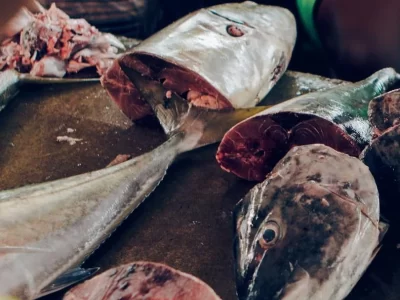Agriculture in Seychelles accounts for less than 3 per cent of GDP and is based on only about 3.4 per cent of the total land size of the country.
The land is divided into two major agroclimatic zones – the mountainous forest zone and the coastal plateau. Most crop farming is irrigationdriven, and both food crop-based systems and perennial crop-based systems can be found in the country. The main crops include coconut, cinnamon, vanilla, sweet potato, cassava, banana and tuna, while livestock production includes goats, pigs and chickens.
Most farms are less than two hectares in size. Apart from commercial farmers, who are more likely to have farms larger than 0.5 hectares, a lot of private individuals also engage in small-scale, home-based farming for domestic use. It is estimated that only about 500 hectares of privately owned land in Seychelles is currently being used for agriculture.
The Ministry of Agriculture, Climate Change and Environment oversees the sector, which is driven by the Seychelles National Agricultural Investment Plan. The plan aims to boost food production and security and reduce dependence on imports, which currently account for about 50 per cent of food consumed annually. This will be achieved by strengthening the sector through support for small- and medium-scale farmers, making optimum use of the available land resources and positioning agriculture as a complement to the blue economy.
The government aims to forge partnerships with the private sector to boost investment and take advantage of the specialised skills available in the sector. The plan aims to make agricultural and food systems more inclusive and efficient through initiatives such as the adoption of modern agricultural practices, including the use of new and innovative technologies, integrated crop management and sustainable land use; the transformation, conservation and commercialisation of value-added products in selected commodity chains; and regional and international collaboration in applied agricultural research and agricultural modernisation.
Seychelles is one of the countries in the world that is most focused on climate-smart agriculture, and it has adopted several measures to support adaptation, including the promotion of more sustainable flood management and the protection of habitats; the use of land least likely to see flooding and other extreme weather events; and incorporating high standards of water efficiency into agricultural practices.
Market Potential
The key driver for agricultural development is the limited land capacity, which requires the development of smart and innovative practices to deliver optimum results.
Under the Seychelles National Agricultural Investment Plan, food commodities have been identified that have the highest potential to support food security. These will be given special attention, and include fruit, vegetables, pork, poultry and fish. As an upper-middle-income country with the highest per capita income in Africa, the population of Seychelles is well placed to afford and support local production, which is the focus of the government’s agenda.
The government envisages a greater role for the private sector in the pursuit of its food security goals and is actively seeking to explore partnerships with investors to enhance production and stimulate innovation. Various donors and financing schemes have supported projects in Seychelles that promote the development of knowledge and evidence on the effectiveness of climate-smart agriculture in improving food security, mitigating climate change and improving the adaptive capacities of production systems and populations.
Agencies such as the African Development Bank, the Food and Agriculture Organization and the European Union have also invested in the development of climate-smart agriculture innovations in Seychelles, creating a foundation to support improved production outcomes.
Investment Opportunities
• Climate-smart cultivation of crops and livestock
• Development of post-harvest systems and infrastructure
• Support of knowledge management in the agriculture sector
• Support of institutions’ capacities in the agriculture sector
• Post-harvest value addition
• Agricultural innovations including indoor farming techniques such as vertical farming and hydroponics. ■TG











Comments